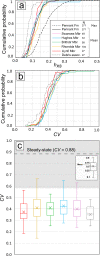Quantitative constraints on flood variability in the rock record
- PMID: 37291113
- PMCID: PMC10250471
- DOI: 10.1038/s41467-023-38967-8
Quantitative constraints on flood variability in the rock record
Abstract
Floods determine river behaviour in time and space. Yet quantitative measures of discharge variability from geological stratigraphy are sparse, even though they are critical to understand landscape sensitivity to past and future environmental change. Here we show how storm-driven river floods in the geologic past can be quantified, using Carboniferous stratigraphy as an exemplar. The geometries of dune cross-sets demonstrate that discharge-driven disequilibrium dynamics dominated fluvial deposition in the Pennant Formation of South Wales. Based on bedform preservation theory, we quantify dune turnover timescales and hence the magnitude and duration of flow variability, showing that rivers were perennial but prone to flashy floods lasting 4-16 h. This disequilibrium bedform preservation is consistent across 4 Ma of stratigraphy, and coincides with facies-based markers of flooding, such as mass-preservation of woody debris. We suggest that it is now possible to quantify climate-driven sedimentation events in the geologic past, and reconstruct discharge variability from the rock record on a uniquely short (daily) timescale, revealing a formation dominated by flashy floods in perennial rivers.
© 2023. The Author(s).
Conflict of interest statement
The authors declare no competing interests.
Figures







References
-
- Milliman JD, Meade RH. Worldwide delivery of river sediment to the oceans. Geology. 1983;91:1–21.
-
- Baker, V. R., Kochel, R. C. & Patton, P. C. Flood Geomorphology (Wiley-Interscience, 1988).
-
- Trümper S, et al. Late Palaeozoic red beds elucidate fluvial architectures preserving large woody debris in the seasonal tropics of central Pangaea. Sedimentology. 2020;67:1973–2012. doi: 10.1111/sed.12692. - DOI
-
- Palik B, et al. Geomorphic variation in riparian tree mortality and stream coarse woody debris recruitment from record flooding in a coastal plain stream. Écoscience. 2016;5:551–560. doi: 10.1080/11956860.1998.11682487. - DOI
MeSH terms
LinkOut - more resources
Full Text Sources
Medical
Miscellaneous

